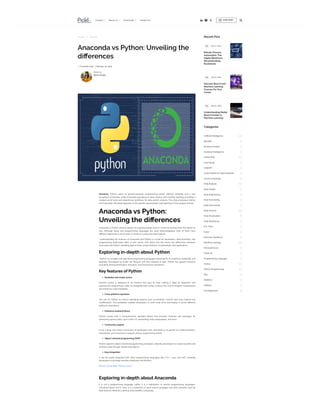Anaconda vs Python: Understanding the differences
- 1. Courses About Us Community Contact Us Home Python Anaconda vs Python: Unveiling the differences 6 minute read February 14, 2024 Summary: Python caters to general-purpose programming needs, offering versatility and a vast ecosystem of libraries, while Anaconda specializes in data science and machine learning, providing a curated set of tools and streamlined workflows for data-centric projects. The choice between Python and Anaconda ultimately depends on the specific requirements and objectives of the project at hand. Anaconda vs Python: Unveiling the differences Anaconda vs Python, there is always an ongoing debate when it comes to zeroing down the option to one. Although these two programming languages are used interchangeably, both of them have different objectives to serve when it comes to coding and data analysis. Understanding the nuances of Anaconda and Python is crucial for developers, Data Scientists, and programming enthusiasts alike. In this article, we’ll delve into the seven key differences between Anaconda and Python, shedding light on their unique features, functionalities, and applications. Exploring in-depth about Python Python is a versatile and high-level programming language renowned for its simplicity, readability, and flexibility. Developed by Guido van Rossum and first released in 1991, Python has gained immense popularity among developers, educators, and researchers worldwide. Key features of Python Readable and simple syntax Python’s syntax is designed to be intuitive and easy to read, making it ideal for beginners and experienced programmers alike. Its straightforward syntax reduces the cost of program maintenance and enhances code readability. Cross-platform operation You can run Python on various operating systems such as Windows, macOS, and Linux without any modifications. This portability enables developers to write code once and deploy it across different platforms seamlessly. Extensive standard library Python comes with a comprehensive standard library that provides modules and packages for performing various tasks, such as file I/O, networking, data manipulation, and more. Community support It has a large and active community of developers who contribute to its growth by creating libraries, frameworks, and resources to support various programming needs. Object-oriented programming (OOP) Python supports object-oriented programming paradigms, allowing developers to create reusable and modular code through classes and objects. Easy integration It can be easily integrated with other programming languages like C/C++, Java, and .NET, enabling developers to leverage existing codebases and libraries. (Python Cheatsheet: Explore more ) Exploring in-depth about Anaconda It is not a programming language; rather, it is a distribution of several programming languages, including Python and R. Also, it is a collection of open-source packages and tools primarily used for Data Science, Machine Learning, and scientific computing. Written by: Neha Singh Recent Post Categories 01 July 11, 2024 Robotic Process Automation: The Digital Workforce Revolutionising Businesses 02 July 10, 2024 Discover Best AI and Machine Learning Courses For Your Career 03 July 10, 2024 Understanding Radial Basis Function In Machine Learning Artificial Intelligence (52) Big Data (6) Business Analyst (1) Business Intelligence (7) Career Path (60) Case Study (1) ChatGPT (3) Cheat Sheets for Data Scientists (2) Cloud Computing (6) Data Analysts (50) Data Celebs (2) Data Engineering (4) Data Forecasting (2) Data Governance (4) Data Science (133) Data Visualization (8) Data Warehouse (1) ETL Tools (1) Excel (2) Interview Questions (6) Machine Learning (69) Microsoft Excel (7) Power BI (2) Programming Language (7) Python (20) Python Programming (27) SQL (11) Statistics (4) Tableau (1) Uncategorized (9) SUBSCRIBE
- 2. Key features of Anaconda Python and R distribution Anaconda provides a pre-packaged distribution of Python and R programming languages along with their respective package managers (pip for Python and CRAN for R). Conda package manager Anaconda uses the conda package manager, which allows users to easily install, manage, and update packages and dependencies for Python and other languages within the Anaconda environment. Comprehensive package collection It comes with a vast collection of pre-built and optimized packages for data science, machine learning, scientific computing, and related fields. This includes popular libraries such as NumPy, pandas, scikit- learn, TensorFlow, PyTorch, matplotlib, and many others. Cross-platform compatibility Similar to Python, Anaconda is available for multiple operating systems, including Windows, macOS, and Linux, ensuring cross-platform compatibility for users across different environments. Integrated Development Environment (IDE) Anaconda includes the option to install and use integrated development environments like Jupyter Notebook and Spyder, which provide interactive environments for data analysis, visualization, and development. Data visualization tools One of the unique features of Anaconda is that it provides tools and libraries for data visualization, including matplotlib, seaborn, Plotly, and Bokeh, allowing users to create interactive and informative visualizations for their data analysis projects. Community and Support Anaconda has a large and active community of users and developers who contribute to its development, provide support, and share resources and best practices for using Anaconda and its associated tools. Anaconda vs Python Anaconda and Python are both powerful tools in the world of programming and data science. However, they differ significantly in their scope, features, and applications. Here are some of the key differences between Anaconda and Python. Parameters Python Anaconda Purpose and scope General-purpose programming language known for its simplicity and versatility. It serves as a foundational tool for developing a wide range of applications, including web development, automation, scientific computing, and artificial intelligence. It is a Python distribution tailored specifically for data science and machine learning tasks. It comes bundled with a comprehensive set of libraries and tools optimized for data analysis, manipulation, visualization, and modeling. Library It has an extensive library ecosystem encompassing a vast array of third- party packages and modules catering to diverse programming needs. Developers have access to libraries for data manipulation (e.g., NumPy, pandas), visualization (e.g., Matplotlib, Seaborn), machine learning (e.g., scikit- learn, TensorFlow), and more. Anaconda builds upon Python’s library ecosystem by pre-packaging many essential data science and machine learning libraries. It includes popular tools like NumPy, pandas, Matplotlib, scikit-learn, Jupyter Notebooks, and TensorFlow, streamlining the setup process for data-centric projects. Community and support Enjoys a vast and vibrant community of developers, contributors, and enthusiasts worldwide. Its large community ensures robust support, extensive documentation, and a wealth of educational resources, making it accessible to learners and professionals alike. While Anaconda has a dedicated community focused on data science and machine learning, it may not match the scale and diversity of Python’s broader community. However, Anaconda users benefit from specialized forums, tutorials, and resources tailored to data science workflows. Use cases Python’s versatility and simplicity have made it a staple in the software development landscape. From web development and automation to data science and artificial intelligence, Python powers a diverse range of applications and use cases, demonstrating its adaptability and scalability across industries. Anaconda is widely adopted across industries for data analysis, machine learning, and scientific computing. Its comprehensive suite of tools and libraries makes it a preferred choice for data scientists, researchers, and enterprises seeking to leverage data- driven insights for decision-making and innovation. Anaconda vs Python- making the choice: which one should you choose? The decision between Anaconda and Python hinges on your specific requirements and preferences. Consider the following factors: 1. Project Scope and requirements Evaluate the nature of your projects. If you primarily work on data science, machine learning, or scientific computing tasks, Anaconda’s specialized features and bundled libraries may offer a more streamlined workflow. 2. Dependency management needs If efficient package and environment management are paramount, Anaconda’s Conda package manager provides a robust solution. However, for lightweight projects or those requiring minimal dependencies, Python’s native package management may suffice. 3. Community and support Assess the importance of community support and resources. Python’s vast community ensures comprehensive support and a wealth of learning resources. Conversely, Anaconda’s community, while robust, may not match Python’s sheer scale and diversity. Frequently asked questions Which is better: Python or Anaconda? Both Python and Anaconda serve different purposes. Python is a general-purpose programming language, while Anaconda is a distribution optimized for data science. The choice depends on project
- 3. FACEBOOK TWIT TER MAIL LINKEDIN Post written by: Neha Singh I’m a full-time freelance writer and editor who enjoys wordsmithing. The 8 years long journey as a content writer and editor has made me relaize the significance and power of choosing the right words. Prior to my writing journey, I was a trainer and human resource manager. WIth more than a decade long professional journey, I find myself more powerful as a wordsmith. As an avid writer, everything around me inspires me and pushes me to string words and ideas to create unique content; and when I’m not writing and editing, I enjoy experimenting with my culinary skills, reading, gardening, and spending time with my adorable little mutt Neel. FOLLOW 0 Article Rating Subscribe 0 COMMENTS You May Also Like requirements; Python offers versatility, while Anaconda provides specialized tools for data analysis and machine learning. Is Python bigger than Anaconda? Anaconda is a Python distribution that includes a Python interpreter, packages, libraries, and tools for data science and machine learning, hence is larger than Python. What is the difference between Anaconda and Python IDE? Anaconda is a Python distribution that bundles the Python interpreter with additional packages and tools for data science. A Python IDE (Integrated Development Environment) is a software application specifically designed for writing, debugging, and testing Python code. Anaconda includes IDEs like Spyder and Jupyter Notebook. Is Anaconda a type of Python? Anaconda is not a type of Python; rather, it is a Python distribution. Anaconda includes the Python programming language along with additional packages and tools tailored for data science and machine learning tasks. It provides an environment for Python development with specialized capabilities. Conclusion Anaconda and Python are indispensable tools in the realm of programming and data science. While Python serves as a versatile programming language for various applications, Anaconda offers a comprehensive ecosystem tailored for data analysis, machine learning, and scientific computing. By understanding the key differences between Anaconda and Python, developers and data scientists can harness the power of these tools to drive innovation, solve complex problems, and unlock new possibilities in the digital era. Individuals wanting to learn more about Python can enroll for the Pickl.AI’s Python for Data Science course. This course will help upskill and upgrade your knowledge on Python and its application. Click on the link below https:/ /www.pickl.ai/course/python-certification-training-program PYTHON PROGRAMMING Best Resources for Kids to learn Data Science with Python Rahul Kumar May 31, 2023 9 minute read PYTHON PROGRAMMING Simply Explaining Method Overriding & Method Overloading in Python Ashutosh Jindal August 3, 2023 8 minute read
- 4. Pickl.AI © Pickl.AI 2024. All rights reserved



